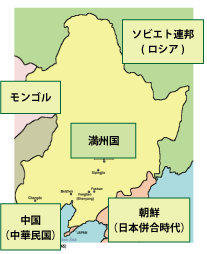
満洲国は、1932年から1945年の間、満洲(中国東北部)に存在した大日本帝国の傀儡国家である。
1843年、清朝はアヘン戦争後に進出諸国の治外法権を受諾した。1858年、ロシア帝国も治外法権を獲得し、1860年に中国北東部の領有権得た。日本は1871年(明治4)の日清修好条規で清国と対等国交条約を締結した。更に日清戦争後の下関条約により、清国に対する治外法権を得た。ロシアは日清戦争直後の三国干渉のインセンティブで満洲の鉄道敷設権を得た(露清密約)。日本は、ロシアが満洲全体を実質支配する「南下政策」が日本安全保障の脅威とみなした。1900年(明治33)、ロシアは義和団の乱に乗じて満洲を占領、権益を独占した。日本はアメリカ等と満洲の開放を主張し英国と日英同盟を締結した。1904年、日本は日露戦争に勝利し、南樺太割譲、ポーツマス条約で朝鮮半島や遼東半島の租借権と鉄道経営権を獲得した。しかし、日本は政策を180度転換し、ロシアと共同で満洲の権益確保を推進したことにより、中国進出に出遅れたアメリカと対立した。
1904年、日本は日露戦争に勝利し、南樺太割譲、ポーツマス条約で朝鮮半島や遼東半島の租借権と鉄道経営権を獲得した。
しかし、日本は政策を180度転換し、ロシアと共同で満洲の権益確保を推進したことにより、中国進出に出遅れたアメリカと対立した。1931年(昭和6)9月、満洲事変が勃発、関東軍により満洲全土が占領された。その後、関東軍主導の下に同地域は中華民国からの独立を宣言し、1932年(昭和7)3月、満洲国が建国された。元首は清朝最後の皇帝・愛新覚羅溥儀(あいしんかぐらふぎ)が就いた。その後、列強からの満州傀儡政権への非難が拡大したため、日本は1933年(昭和8)に国際連盟を脱退した。
その当時、ドイツやイタリア、タイ等の第二次世界大戦の日本の同盟国や友好国、そしてスペイン等の枢軸陣営寄りの中立国や、エルサルバドルやポーランドコスタリカなどの後の連合国の構成国(13か国)も満洲国を承認した。さらにソビエト連邦も領土不可侵を約束して公館を設置した。また英米仏など国交を樹立していなかった国も次々と満州に経済進出し、人的交流や交易をおこなっていた。第二次世界大戦末期の1945年(昭和20)、日ソ中立条約を破ったソ連による関東軍への攻撃と、その後の日本の降伏により、8月18日に満洲国皇帝・溥儀が退位して満洲国は滅亡した。
参考:①wikipedia 満州国
②公益財団法人日本郵趣協会編 『日本切手専門カタログ 日本関連地域編2012』P74-90
Manchukuo is a puppet state of the Empire of Japan that existed in Manchuria (northeast China) between 1932 and1945.In 1843, the Qing dynasty accepted the extraterritoriality of the countries that entered the country after theOpium War. In 1858, the Russian Empire also gained extraterritoriality, and in 1860 gained sovereignty over northeastern China. Japan signed an equal diplomatic treaty with the Qing dynasty under the Sino-Japanese Friendship and Treaty of 1871 (Meiji 4). Furthermore, the Treaty of Shimonoseki after the Sino-Japanese War gave extraterritoriality to the Qing dynasty. Russia obtained the right to lay a railway in Manchuria with the incentive for Triple Intervention immediately after the Sino-Japanese War (Li-Lobanov Treaty). Japan regarded Russia’s “southward policy,” which effectively controls the entire Manchuria, as a threat to Japan’s security. In 1900 (Meiji 33), Russia took advantage of the Boxer Rebellion to occupy Manchuria and monopolize its interests. Japan insisted on the opening of Manchuria with the United States and other countries, and concluded an Anglo-Japanese Alliance with the United Kingdom.
In 1904, Japan won the Russo-Japanese War, ceded South Sakhalin, and acquired the right to lease and manage theKorean Peninsula and the Liaodong Peninsula under the Treaty of Portsmouth. However, Japan confronted the UnitedStates, which was late in entering China, by changing its policy 180 degrees and promoting the securing of interests in Manchuria jointly with Russia. In September 1931 (Showa 6), the Manchurian Incident broke out, and the entire Manchuria was occupied by the Kwantung Army. After that, under the leadership of the Kwantung Army, the region declared independence from the Republic of China, and Manchuria was founded in March 1932. The head of state was the last emperor of the Qing dynasty, Puyi Puyi. After that, Japan withdrew from the League of Nations in 1933 (Showa8) due to widespread criticism of the Manchurian puppet government from the great powers. At that time, Japan’s allies and friendly nations of World War II such as Germany, Italy and Thailand, neutral nations closer to the pivotal camp such as Spain, and later allied nations such as El Salvador, Poland , Costa Rica were also full. Approved the nation(13country).In addition, the Soviet Union promised to invade the territory and set up a legation. In addition, countries such as Britain,the United States, and France that had not established diplomatic relations also advanced into Manchuria one afteranother, and engaged in human exchange and trade. In 1945 (Showa 20) at the end of World War II, the Soviet Union’s attack on the Kwantung Army, which broke the Soviet-Japanese Neutrality Treaty, and the subsequent surrender of Japan led to the abdication of Emperor Manchuria and Puyi on August 18. Manchukuo was destroyed.
Reference: (1) wikipedia Manchuria
(2) Japan Philatelic Society Foundation, “Japan Stamp Specialized Catalog, Japan-Related Areas 2012” P74-90
